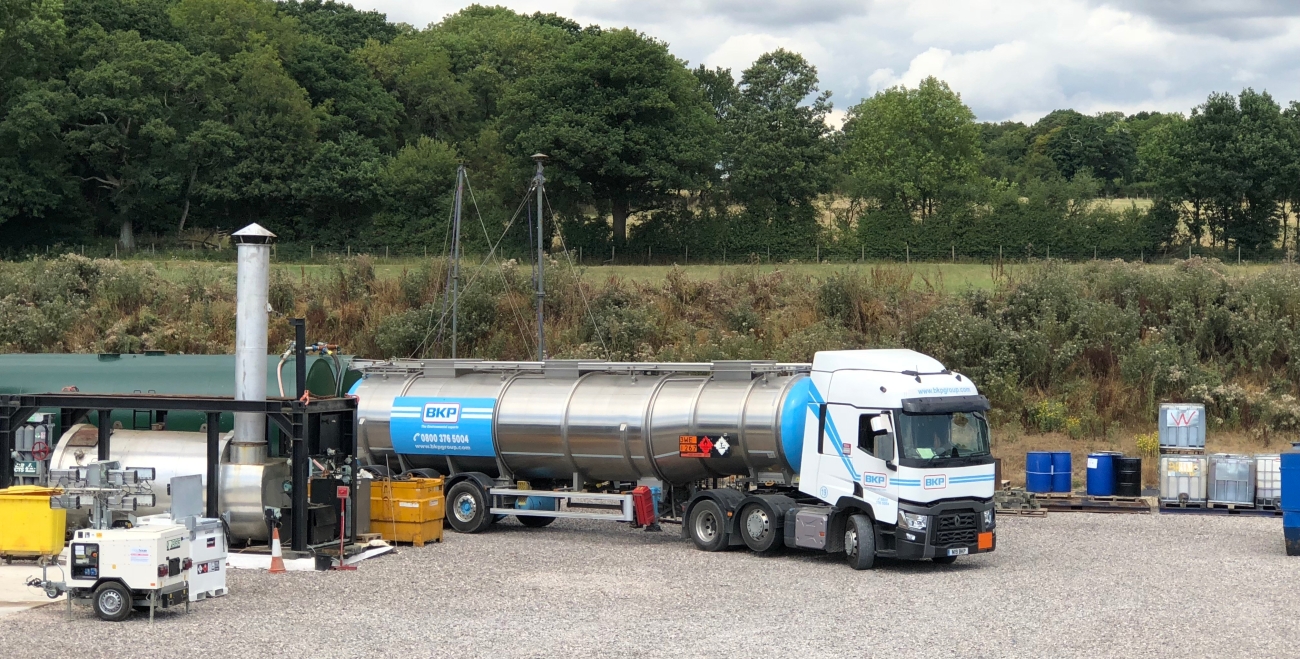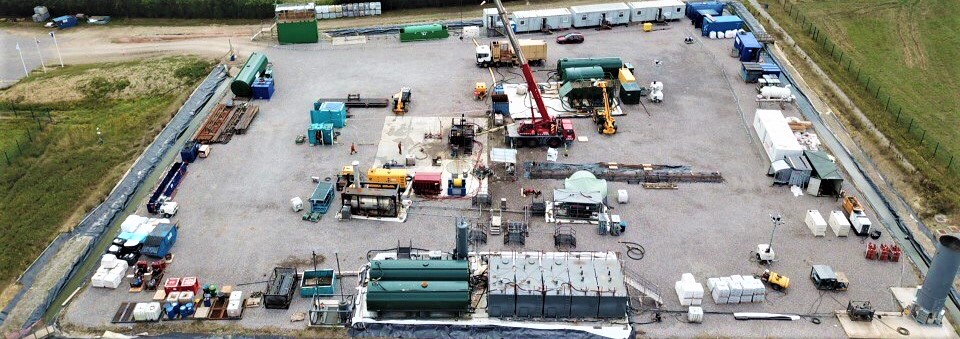
Horse Hill oil site near Gatwick Airport, October 2018. Photo: Used with the owner’s consent
The Horse Hill oil site in Surrey looks increasingly likely to be one of the UK’s leading onshore producing fields, its leading investor said this afternoon.
UK Oil and Gas plc, announcing results from extended well tests, said flow rates from one section of the Kimmeridge Limestone was higher than that achieved two years ago.
The company said the Kimmeridge Limestone (KL) 3 zone had produced continuous oil rates of 563-771 barrels of oil per day (bopd). This flow was recorded over 24 hours and was above the rate of 464 bopd measured over 7.5 hours during initial tests in 2016, UKOG said.
In a statement to investors, UKOG said four tankers of the KL3 crude had been sent to the Fawley oil refinery in Hampshire. Gas rates reached up to 186,000 cubic feet per day, it added.
UKOG’s chief executive, Stephen Sanderson, said:
“Whilst these are early days in the planned KL3 EWT [Extended Well Test] sequence, with the well still “cleaning-up”, the continuous and sustained high oil rates can only be seen as highly encouraging for the overall EWT objective of establishing the commerciality of the Kimmeridge.
“The Directors consider that these positive KL3 test results now make it increasingly likely that both the Kimmeridge and Portland oil pools are set to make Horse Hill one of the UK’s leading onshore producing oil fields.
“Permanent production at Horse Hill is targeted in 2019.”

The statement said the crude oil from the KL3 extended well test was a light 40-41o API. It flowed continuously to the surface, without the need for a pump, for 50 hours.
It said the test had produced no formation water, unlike the recent well test at Balcombe (see DrillOrDrop report). The water extracted from the well was wholly returned heavy completion brine.
It also suggested that the KL3 and KL4 zones were one single connected oil pool, extending vertically to 358ft.
UKOG said it would test the KL4 zone next. This reported a rate of 901 bopd during a four-hour period in 2016.
10/10/18 Typo corrected to “completion brine”
Categories: Industry

Great news Ruth Hayhurst.Paul seaman .For home grown oil for UK plc .Local jobs and did Ukog not say they would give a % of profits to local economy.Win Win .And no fracking and no importing from half way around the world .Is that not Eco friendlier all protestors??
So put that in your pipe, Prof. Smythe.
P.S: what is “competition brine” ?
Completion brine. Fresh water with salt added to attain a density sufficient to stop the well flowing i.e. kill weight, hydrostatic head > reservoir pressure. Well control …..
“The water extracted from the well was wholly returned heavy ***competition*** brine.”
Merely highlighting the quality of reporting.
Sorry I didn’t read the post – I see the mistake now – Ruth – Paul can you correct please?
That’s done, Paul.
The mistake was more the quality of the typing than of reporting. Alas, we can’t afford a proof reader…
What wonderful news. Lots of money for the local economy and shareholders and, of course, it is not a fracking site either
Just to note, WYF oil is mainly offshore.
So the hurdle to jump,over to be the leading onshore producing field is not very high at present.
But interesting all the same.
I think Wytch produced 100k+ barrels at one time hewes62, but I may be wrong.
HH I believe is indicated to be (outlined) planned for 500 tonnes per day-not sure what that is in barrels. My suspicion is if that is possible, the output is probably as much calibrated to reasonable lorry movement capacity as output capacity. That is certainly speculation on my part-but if it is OK for the Prof., why not.
Of course, the big question is will it sustain over time. Hopefully next one to be answered.
110,000 bopd peak production
According to http://www.reference.com/science/convert-metric-tons-barrels-7e9fe650a0b35e54, the conversion rate depends (not surprisingly) on the density of the oil.
Crude oil (averaged across the different sources) converts at 7.33 barrels to the metric ton while diesel is 7.5 and gasoline is 8.5 barrels per ton.
1 UK barrel is 36 UK gallons https://www.metric-conversions.org/volume/uk-barrels-to-uk-gallons.htm
Paul – As far as I know through working in the industry 1 bbl = 1 bbl US or UK or anywhere else.
1bbl = 35 Imperial gallons or 42 US gallons
Martin
Yes, it was a big producer. Eastern airways from Aberdeen to Southampton, train to Wareham and then taxi to the site when visiting.
You fellas sound VERY excited, but haven’t we heard all this Gatwick Gusher hype before?
Maybe King Midas has found a way to make oil flow out of clay without using intensive stimulation, nitrogen lifting and the pumps Adrian Watkins films labouring away.
But even if there is such a thing as a continuous pool of Kimmeridge Clay unconventional oil across the Weald (and I don’t believe there is), still a bit of an own goal isn’t it? https://www.theguardian.com/environment/2018/oct/08/global-warming-must-not-exceed-15c-warns-landmark-un-report
Divest while there’s still time https://www.theguardian.com/environment/2018/sep/10/fossil-fuel-divestment-funds-rise-to-6tn
What we have here is world class oil field onshore .So cheap to produce.To take over from north sea oil which is declining rapidly Which was very expensive to produce offshore .And the decommissioning start of North Sea oil field .Great news for UK plc .Local jobs and income for Weald valley .We are all going to be rich .Win Win for all
I think the excitement is showing the true colours of us eco guys, Dorkinian. All these lorry loads of oil from HH to Hamble, and the potential for more. Help to replace those tankers steaming across the Med, being diverted around the oil spill that occurred recently, and making a little dent in the 1.5 degree that they are adding to. More difficult to deal with the Guardian’s 15 degrees, but I’m sure the Guardian reader is not too interested in the placement of a decimal point, having been educated in the DA school of maths.
If the £500 million is invested in Fawley Refinery to increase diesel output perhaps they could brand it eco-diesel, sourced from local ingredients? Sell it via farm shops to the 4X4 drivers on their way back from the school run, or from picking up the new home help from Gatwick, and everyone is happy, and excited.
Maybe they could stimulate more oil production via CO2 “stimulation”? A double eco benefit. Not too sure on that one, I only read the headline, others will know if it has any real merit.
“Eco guy”, congratulations, you are surpassing yourself in new horizons of sophistry.
hewes62-quite an eye opener how 110k barrels can be produced per day on shore with such a small “footprint” above surface and so little impact upon countryside, house prices, environment etc. and within an area full of SSIs. “Alternatively” you could run a dozer over the site and many hectares around it and then plonk some solar panels on top-but the energy produced would still be a fraction of 110k barrels of oil.
Martin
They certainly did and do well and are a good example of what can be done.
Martin “Eco guy’ Collyer, are you forgetting the rapid well depletion? With this type of well typically declining 60% – 70% in the first year that necessitates drilling back to back wells. A refresher for you from your pin up boy https://www.youtube.com/watch?v=Y0Nybav_Icc You won’t last all the way to the end so pick it from 11:30, enjoy 😉